Biomimicking Covert Communication by Time-Frequency Shift Modulation for Increasing Mimicking and BER Performances
Abstract
1. Introduction
- The time- and frequency-shifting unit requirements of the TFSK are theoretically derived for the orthogonality in the time- and frequency-domains. The requirements guarantee the low BER.
- For the large DoM and the low BER, the sequence with a large correlation is multiplied to the whistles, which enables to use of various dolphin whistles without any restrictions. In addition, the orthogonality requirements for the proposed method are also derived.
- Since the sequence makes the whistle spread in the frequency domain, the DoM assessments are conducted to find the unrecognizable spreading parameter. Thus, a two-step DoM assessment is proposed: The 1st step is conducted to find the best length of the sequence. The 2nd step is executed to confirm whether the long-term whistles signal with the selected sequence length is acceptable for the covert communication.
- The computer simulations and the practical lake and ocean experiments were conducted and demonstrated the proposed method had the large DoM and the lower BER compared with the conventional covert communication methods.
2. Proposed Method
2.1. TFSK Performance Analysis According to Whistle Pattern
2.2. Proposed Bio-Mimetic TFSK Modulation Method
3. Proposed DoM Assessment Method
4. Proposed DoM Assessment Method
4.1. Communication Performance Assessment
4.2. Communication Performance Assessment
5. Simulations and Experiments
5.1. Simulation Experiments
5.2. Lake and Ocean Experiments
6. Conclusions
Author Contributions
Funding
Institutional Review Board Statement
Informed Consent Statement
Data Availability Statement
Conflicts of Interest
References
- Yanga, T.C.; Yang, W.-B. Low probability of detection underwater acoustic communications using direct-sequence spread spectrum. J. Acoust. Soc. Am. 2008, 124, 3632–3647. [Google Scholar] [CrossRef] [PubMed]
- Ling, J.; He, H.; Li, J.; Roberts, W.; Stoica, P. Covert underwater acoustic communications. J. Acoust. Soc. Am. 2010, 128, 2898–2909. [Google Scholar] [CrossRef]
- Shu, X.; Wang, J.; Wang, H.; Yang, X. Chaotic direct sequence spread spectrum for secure underwater acoustic communication. J. Appl. Acoust. 2016, 104, 57–66. [Google Scholar] [CrossRef]
- Diamant, R.; Lampe, L. Low Probability of Detection for Underwater Acoustic Communication: A Review. IEEE Access 2018, 6, 19099–19112. [Google Scholar] [CrossRef]
- Qu, F.; Qin, X.; Yang, L.; Yang, T.C. Spread-spectrum method using multiple sequences for underwater acoustic communications. J. Ocean. Eng. 2018, 43, 1215–1225. [Google Scholar] [CrossRef]
- Schmidt, J.H. Using Fast Frequency Hopping Technique to Improve Reliability of Underwater Communication System. Appl. Sci. 2020, 10, 1172. [Google Scholar] [CrossRef]
- Ko, S.J.; Kim, W.J. Robust frame synchronization algorithm in time varying underwater acoustic communication channel. J. Acoust. Soc. Korea 2020, 39, 8–15. [Google Scholar]
- Liu, S.; Qiao, G.; Ismail, A. Covert underwater acoustic communication using dolphin sounds. J. Acoust. Soc. Am. 2013, 133, 1–8. [Google Scholar] [CrossRef]
- Liu, S.; Ma, T.; Qiao, G.; Ma, L.; Yin, Y. Biologically inspired covert underwater acoustic communication by mimicking dolphin whistles. J. Appl. Acoust. 2017, 120, 120–128. [Google Scholar] [CrossRef]
- Ahn, J.M.; Lee, H.J.; Kim, Y.C.; Kim, W.J.; Chung, J.H. Multipath combining method for frequency shift keying underwater communications mimicking dolphin whistle. J. Acoust. Soc. Korea 2018, 17, 404–411. [Google Scholar]
- Ahn, J.M.; Lee, H.J.; Kim, Y.C.; Lee, S.K.; Chung, J.H. Machine learning based dolphin whistle transceiver for bio-inspired underwater covert communication. In Proceeding of the OCEANS 2019, Seattle, WA, USA, 27–31 October 2019. [Google Scholar]
- Ahn, J.M.; Lee, H.J.; Kim, Y.C.; Lee, S.K.; Chung, J.H. Mimicking dolphin whistles with continuously varying carrier frequency modulation for covert underwater acoustic communication. J. Jpn. Appl. Phys. 2019, 58, 1–10. [Google Scholar] [CrossRef]
- Lee, H.J.; Ahn, J.M.; Kim, Y.C.; Lee, S.K.; Chung, J.H. Time-frequency modulation based mimicking dolphin whistle for covert underwater acoustic communication. J. Jpn. Appl. Phys. 2020, 59, 1–15. [Google Scholar] [CrossRef]
- Qiao, G.; Bilal, M.; Liu, S.; Babar, Z.; Ma, T. Biologically inspired covert underwater acoustic communication-A review. J. Phys. Commun. 2018, 30, 107–114. [Google Scholar] [CrossRef]
- Mellinger, D.K.; Martin, S.W.; Morrissey, R.P.; Thomas, L.; Yosco, J.J. A method for detecting whistles, moans and other frequency contour sounds. J. Acoust. Soc. Am. 2010, 129, 4055–4061. [Google Scholar] [CrossRef]
- Gillespie, D.; Caillat, M.; Gordon, J. Automatic detection and classification of odontocete whistles. J. Acoust. Soc. Am. 2012, 134, 2427–2437. [Google Scholar] [CrossRef] [PubMed]
- Lin, T.H.; Chou, L.S. An automatic detection algorithm for extracting the representative frequency of cetacean tonal sounds. J. Acoust. Soc. Am. 2013, 134, 2477–2485. [Google Scholar] [CrossRef] [PubMed]
- Shamir, L.; Yerby, C. Classification of large acoustic datasets using machine learning and crowdsourcing: Application to whale calls. J. Acoust. Soc. Am. 2014, 135, 953–962. [Google Scholar] [CrossRef]
- Watwood, S.L. Whistle Use and Whistle Sharing by Allied Male Bottlenose Dolphins, Tursiops Truncates; Doctor of Philosophy, Massachusetts Institute of Technology: Massachusetts, MA, USA, 2013. [Google Scholar]
- Fan, W.; Zhu, B.; Wu, Y.; Qian, F.; Shui, M.; Du, S.; Zhang, B.; Wu, Y.; Xin, J.; Zhao, Z.; et al. Measurement of the chirp characteristics of linearly chirped pulses by a frequency domain interference method. J. Opt. Express 2013, 21, 13062–13067. [Google Scholar] [CrossRef] [PubMed]
- Kim, Y.; Ahn, J.; Lee, H.; Chung, J. Selection of CDMA and OFDM using machine learning in underwater wireless networks. ICT Express 2019, 5, 215–218. [Google Scholar] [CrossRef]
- Lee, H.; Chung, J. Performance analysis of CDMA and OFDM on underwater acoustic environments. J. ITS 2018, 17, 135–142. [Google Scholar] [CrossRef]
- Liang, X. A high-rate orthogonal space-time block code. J. IEEE Commun. Lett. 2003, 7, 222–223. [Google Scholar] [CrossRef]
- Park, S.; Sung, D. Orthogonal code hopping multiplexing. J. IEEE Commun. Lett. 2002, 6, 529–531. [Google Scholar] [CrossRef]
- Chen, H.; Chu, S.; Guizani, M. On next generation CDMA technologies: The REAL approach for perfect orthogonal code generation. J. IEEE Trans. Veh. Technol. 2008, 57, 2822–2833. [Google Scholar] [CrossRef]
- ITU- Rec. BS 1284-4: General Methods for the Subjective Assessment of Sound Quality. Available online: https://www.itu.int/rec/R-REC-BS.1284/en (accessed on 25 January 2020).
- Streijl, R.C.; Winkler, S.; Hands, D.S. Mean opinion score revisited: Methods and applications, limitations and alternatives. J. Multimed. Syst. 2016, 22, 213–227. [Google Scholar] [CrossRef]
- Kasami, T. Weight Distribution Formula for Some Class of Cyclic Codes. Coord. Sci. Lab. Rep. no. R-285.
- Diana, E.H.; Jabbari, B. Spreading code for direct sequence CDMA and wide band CDMA cellular networks. J. IEEE Commun. Mag. 1998, 36, 48–54. [Google Scholar] [CrossRef]
- Pal, M.; Chattopadhyay, S. A novel orthogonal minimum cross correlation spreading code in CDMA system. In Proceeding of the INTERACT-2010, Chennai, India, 12 March 2010. [Google Scholar]
- Watkins Marine Mammal Sound Database. Available online: https://cis.whoi.edu/science/B/whalesounds/index.cfm (accessed on 25 January 2020).
- Song, H.C.; Cho, C.; Hodgkiss, W.; Nam, S.H.; Kem, S.M.; Kim, B.N. Underwater sound channel in the northeastern east china sea. J. Ocean Eng. 2018, 147, 370–374. [Google Scholar] [CrossRef]
- Kim, M.S.; Lee, T.S.; Im, T.H.; Ko, H.L. The analysis of coherence bandwidth and coherence time for underwater channel environments using experimental data in the west sea Korea. In Proceeding of OCEANS 2016, Shanghai, China, 10–13 April 2016. [Google Scholar]





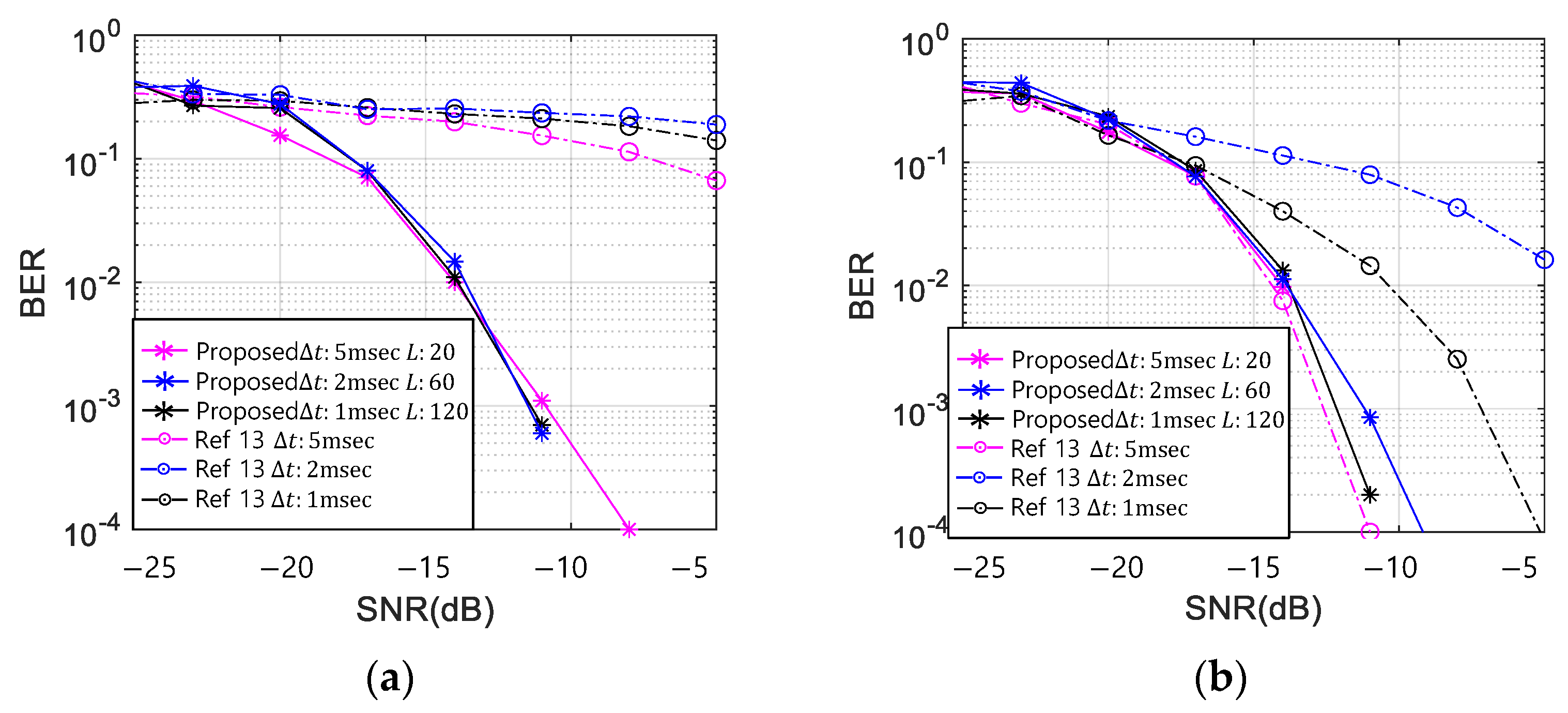
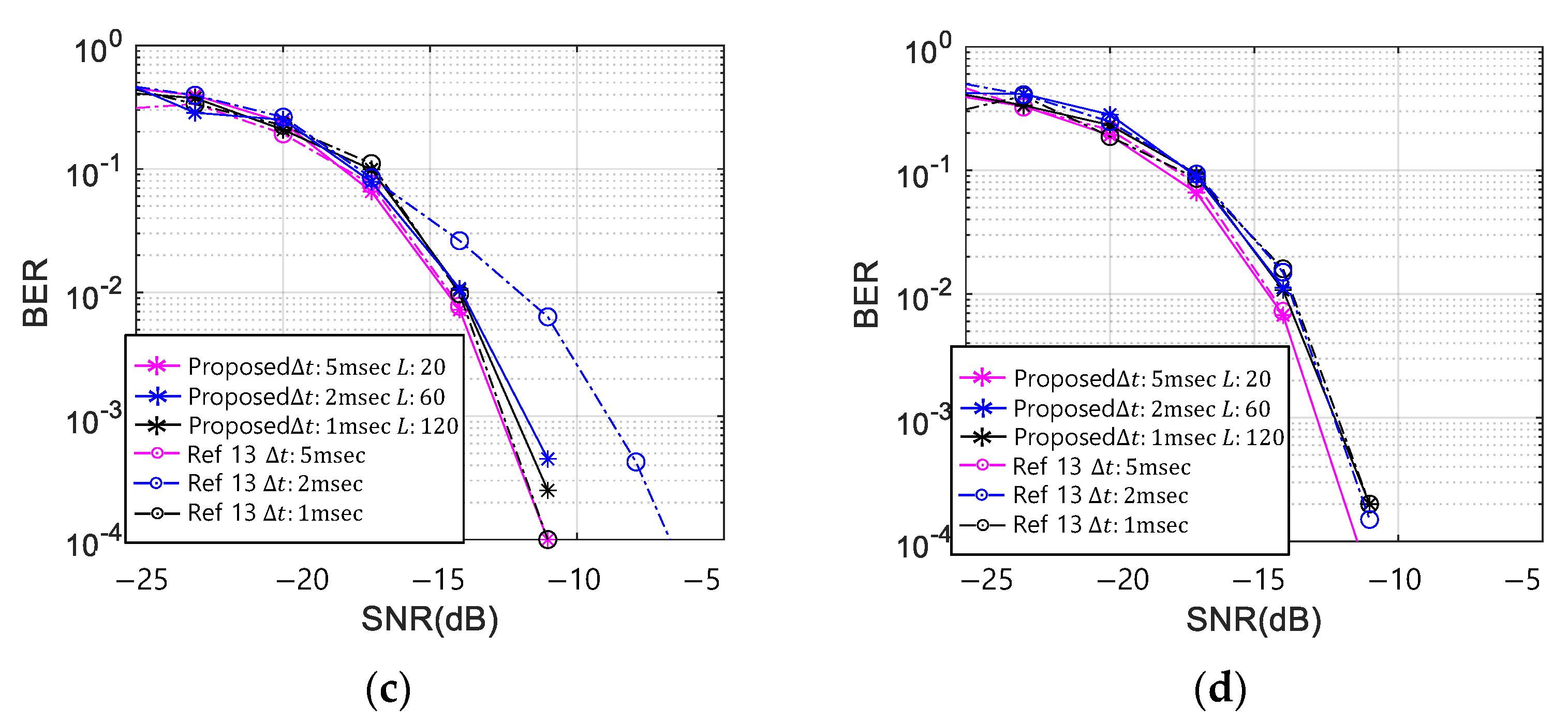

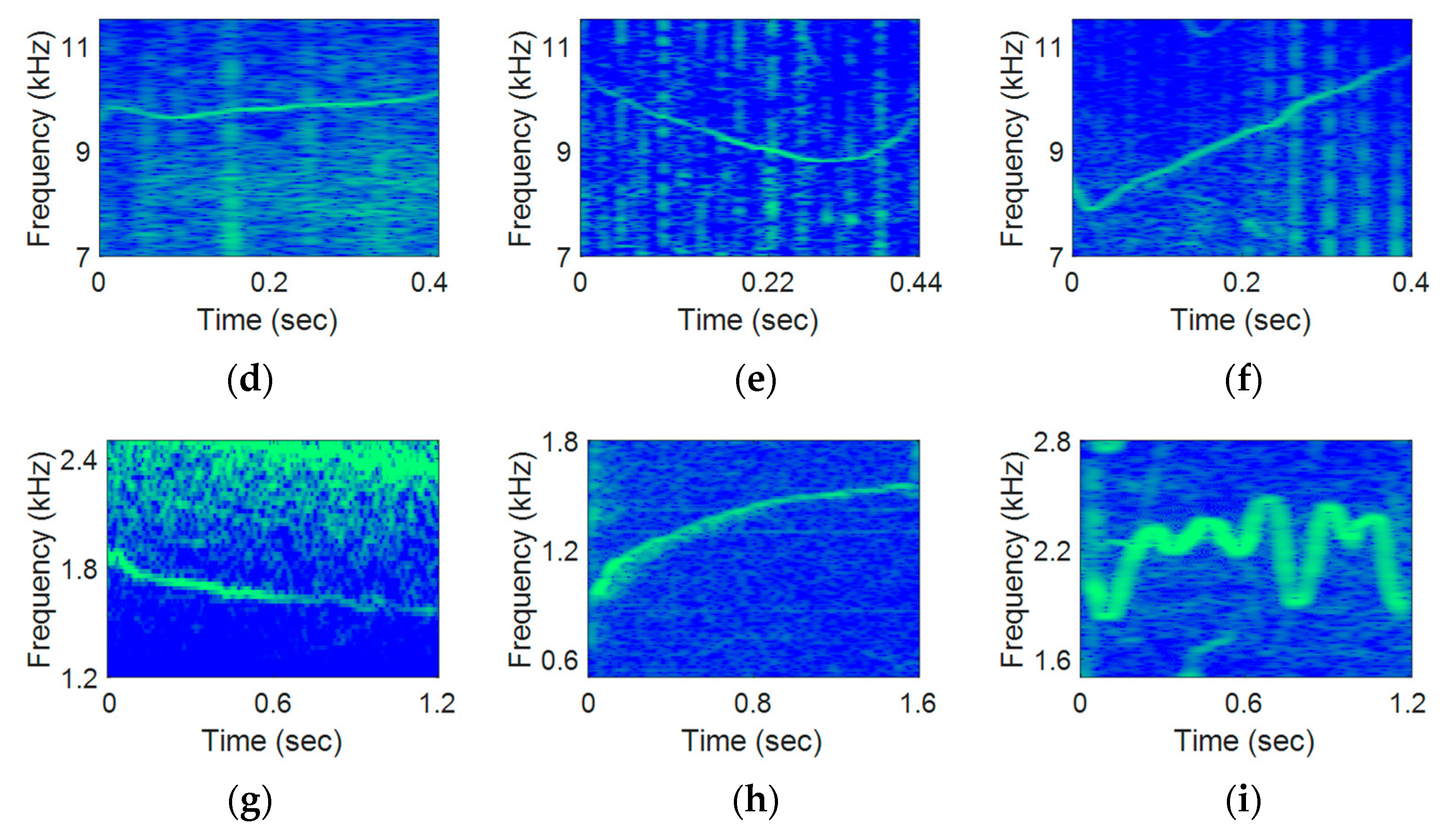

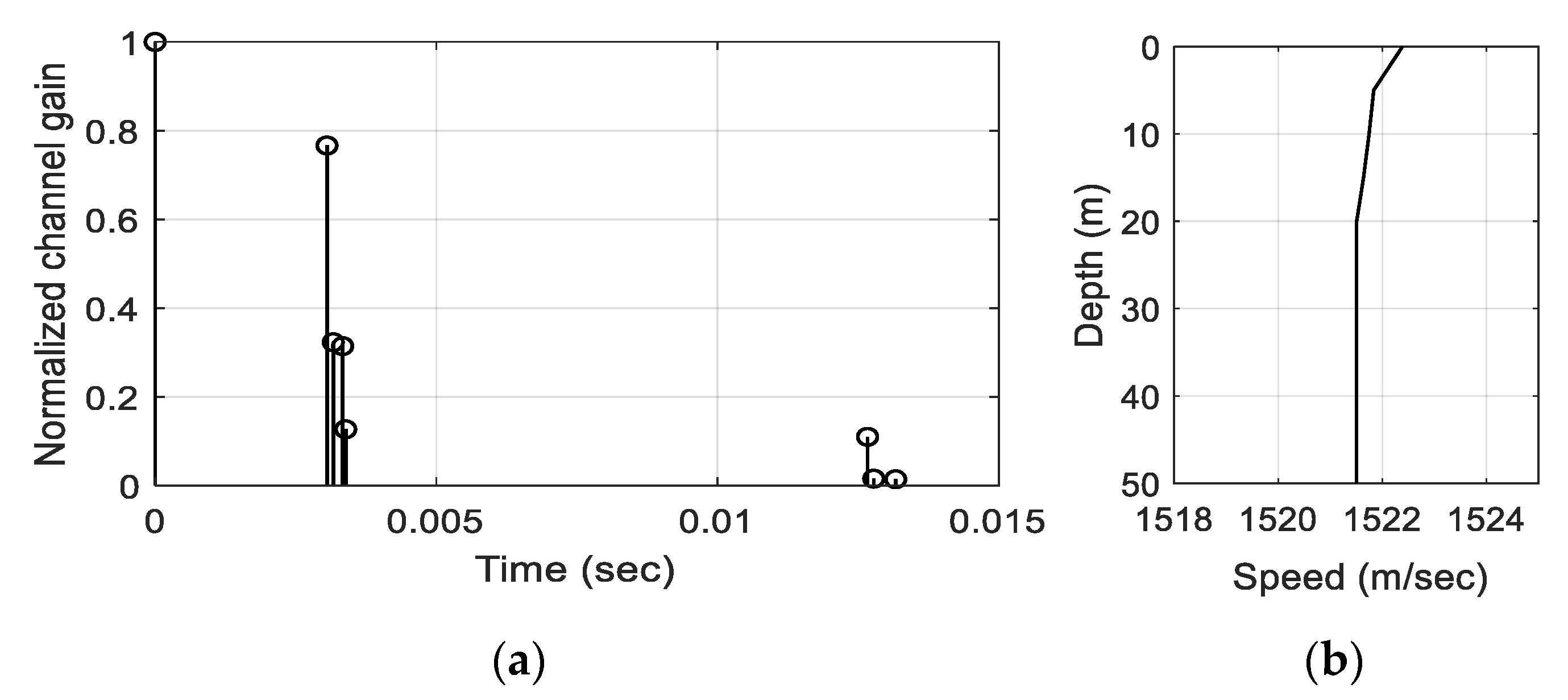
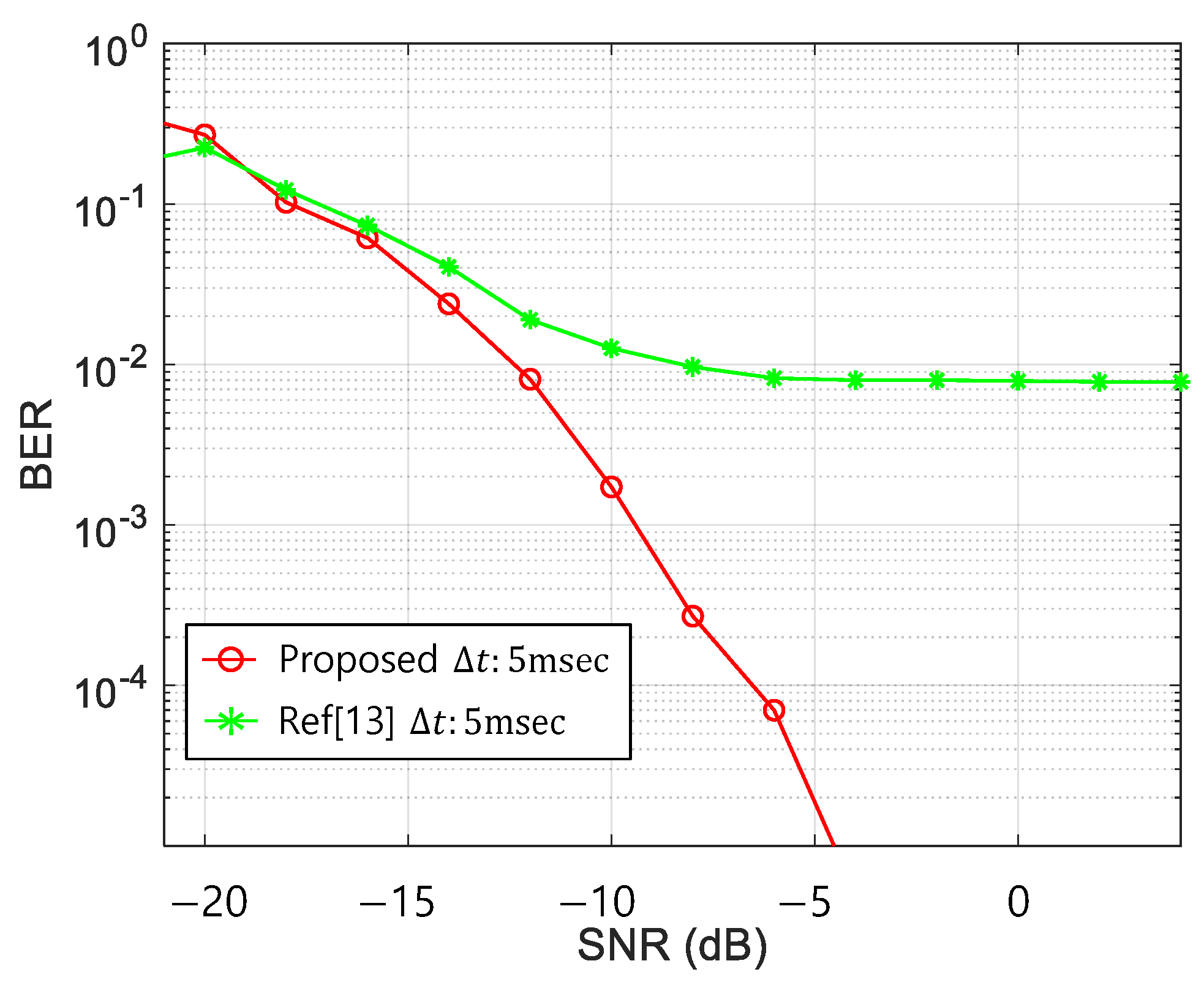

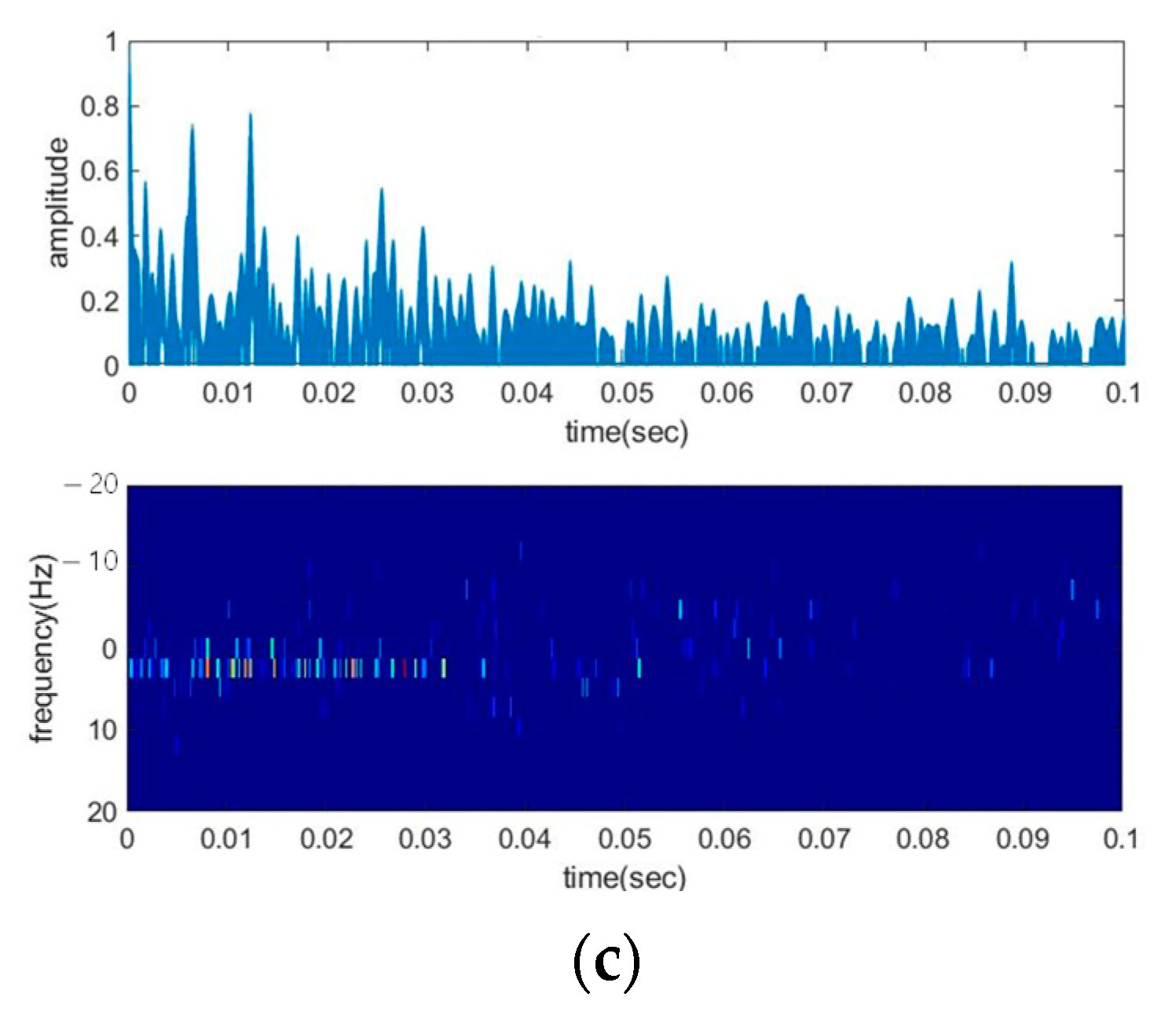
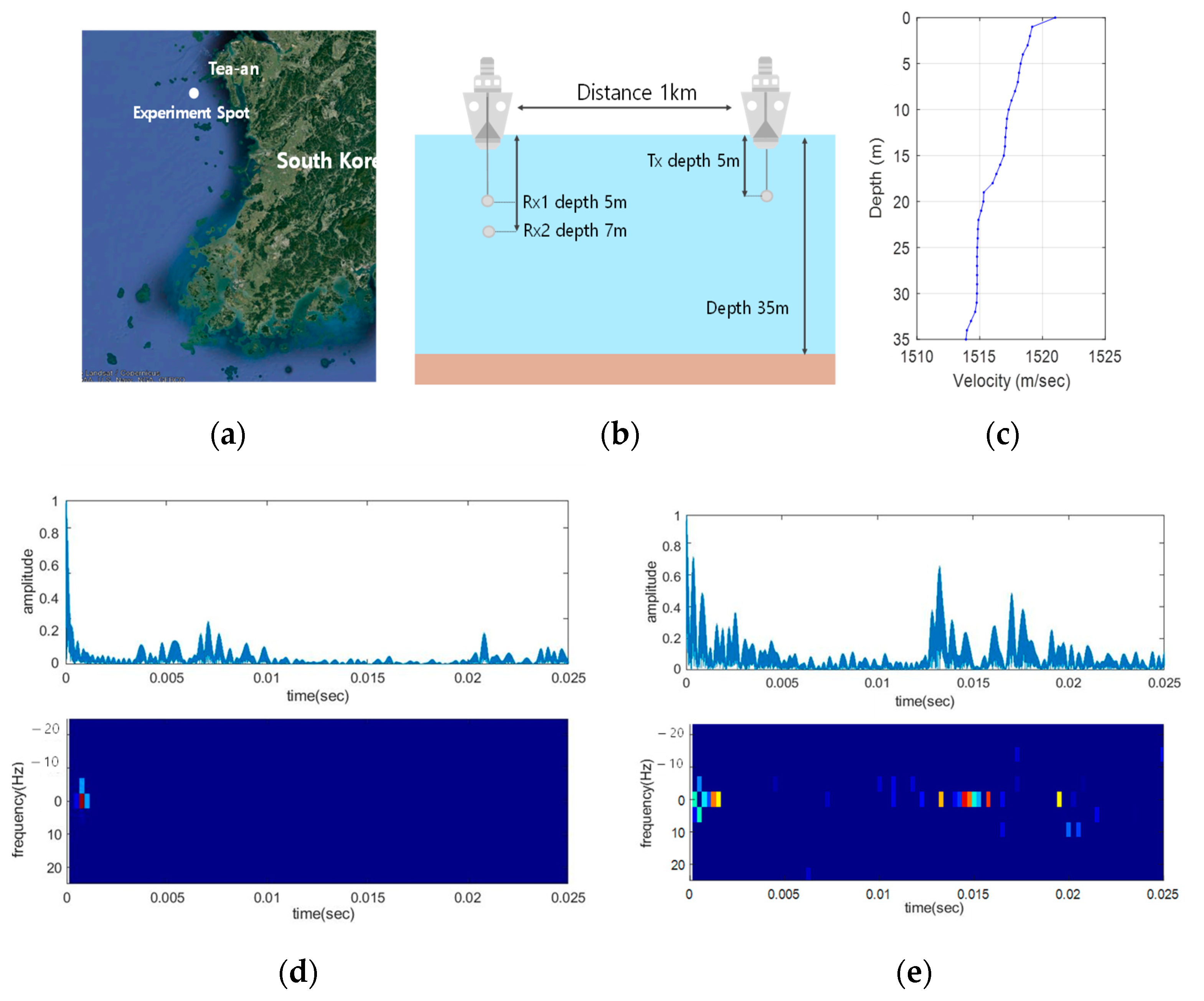
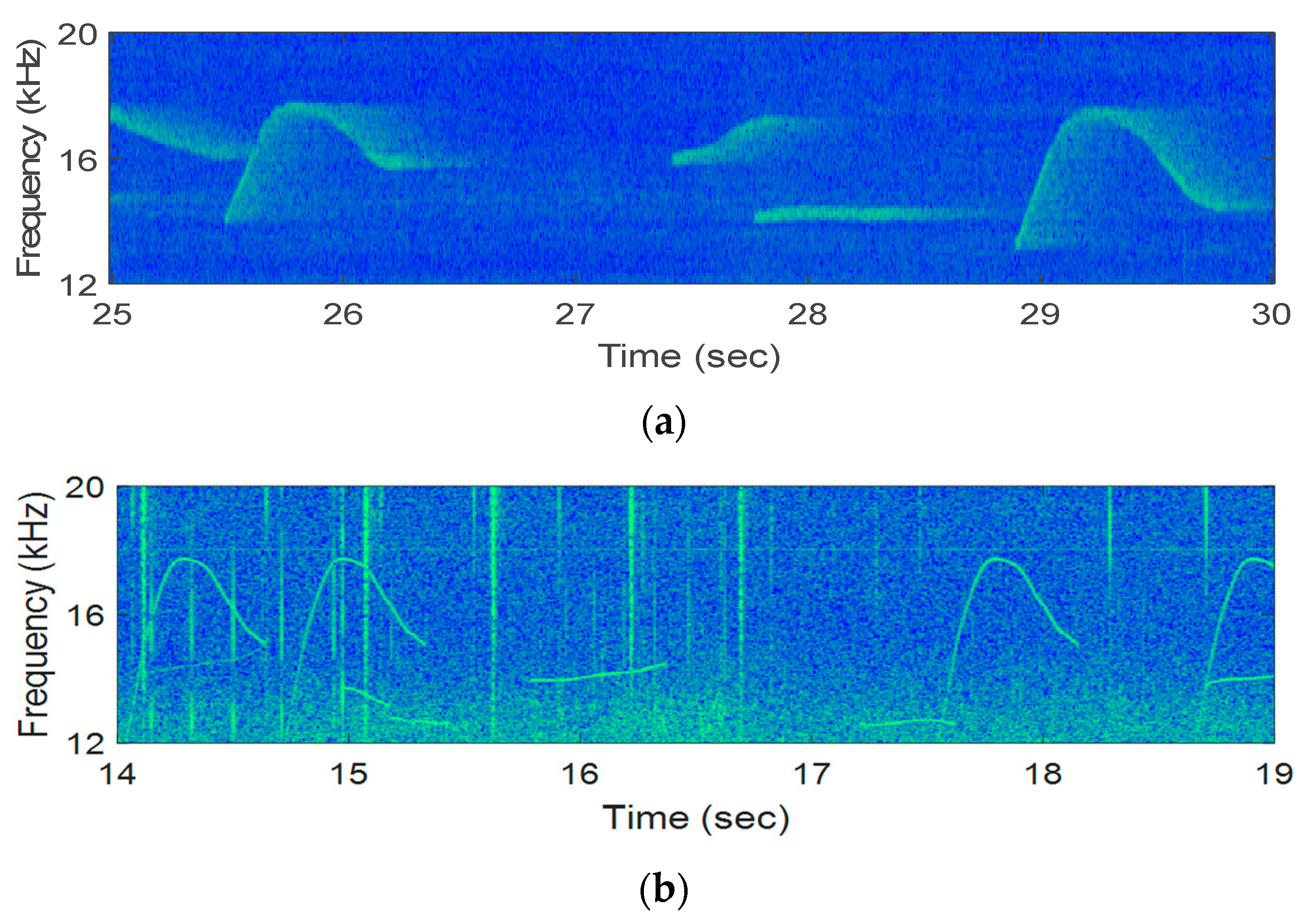
|
|
| Parameter | Values | |||
|---|---|---|---|---|
| (kHz) | 2 | |||
| (kHz/s) | 0 | 1 | 2.5 | 5 |
| (ms) | 200 | 5 | 2 | 1 |
| 1 | 2 | 3 | 4 | 5 |
|---|---|---|---|---|
| Different | Slightly different | Similar | Very similar | same |
| Species | Noise | Real Dolphin | ) | |||
|---|---|---|---|---|---|---|
| 20 | 60 | 100 | 120 | |||
| Killer | 10 dB | 4.7 | 3.8 | 3.2 | 3.1 | 3.2 |
| 20 dB | 4.8 | 3.9 | 3.0 | 2.9 | 3.1 | |
| Delphinus delphis | 10 dB | 4.1 | 4.3 | 4.3 | 4.2 | 4.3 |
| 20 dB | 4.2 | 4.3 | 4.0 | 4.1 | 4.1 | |
| Whistle sided | 10 dB | 4.2 | 4.1 | 4.1 | 4.2 | 4.1 |
| 20 dB | 4.4 | 4.2 | 4.2 | 4.2 | 4.2 | |
| Real Dolphin | Proposed Method | Conventional Method (Ref. [13]) |
|---|---|---|
| 3.72 | 3.81 | 2.81 |
Publisher’s Note: MDPI stays neutral with regard to jurisdictional claims in published maps and institutional affiliations. |
© 2021 by the authors. Licensee MDPI, Basel, Switzerland. This article is an open access article distributed under the terms and conditions of the Creative Commons Attribution (CC BY) license (http://creativecommons.org/licenses/by/4.0/).
Share and Cite
Ahn, J.; Lee, H.; Kim, Y.; Kim, W.; Chung, J. Biomimicking Covert Communication by Time-Frequency Shift Modulation for Increasing Mimicking and BER Performances. Sensors 2021, 21, 2184. https://doi.org/10.3390/s21062184
Ahn J, Lee H, Kim Y, Kim W, Chung J. Biomimicking Covert Communication by Time-Frequency Shift Modulation for Increasing Mimicking and BER Performances. Sensors. 2021; 21(6):2184. https://doi.org/10.3390/s21062184
Chicago/Turabian StyleAhn, Jongmin, Hojun Lee, Yongcheol Kim, Wanjin Kim, and Jaehak Chung. 2021. "Biomimicking Covert Communication by Time-Frequency Shift Modulation for Increasing Mimicking and BER Performances" Sensors 21, no. 6: 2184. https://doi.org/10.3390/s21062184
APA StyleAhn, J., Lee, H., Kim, Y., Kim, W., & Chung, J. (2021). Biomimicking Covert Communication by Time-Frequency Shift Modulation for Increasing Mimicking and BER Performances. Sensors, 21(6), 2184. https://doi.org/10.3390/s21062184








